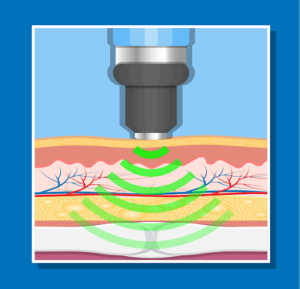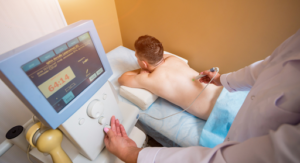If you have recently been injured or if you suffer from chronic pain, you may have heard of Acoustic Compression Therapy (ACT). Many people are skeptical when they hear that a completely non-invasive, drug-free procedure can permanently reduce their pain. This article will give you all the information you need to determine if ACT is the right treatment for you.
How Does Acoustic Compression Therapy Work?
ACT was first discovered in the early ’90s when doctors were using focused sound waves to break up kidney stones. Many patients reported that pain in areas not related to their kidneys was reduced or cured after this treatment. Scientists began researching this phenomenon and found that focused sound waves could be used to treat injuries and pain effectively.
You may have heard ACT described as being the same as an ultrasound. This is not the case. Both procedures utilize sound waves, but the physics are different. The sound waves used in acoustic compression therapy are 1000x more concentrated than those used in ultrasounds. The intensity of this wave can be adjusted and tailored to the patient’s needs.
The short, strong wave generated by the acoustic compression device causes tiny vibrations in surrounding cells. Over the course of several treatments, these vibrations help to break down scar tissue and increase blood flow. The wave will also stimulate the nerves in the area, overriding the pain signals that they are sending to your brain. This is known as the “gate control mechanism.” Over time, those nerves will send signals less frequently, leading to a reduction in pain.
Is It Safe?
Yes! Acoustic compression therapy is FDA approved and has an excellent safety record. It is completely non-invasive and does not interfere with prosthetics or implants and does not bruise or otherwise harm the treatment area. ACT is not appropriate for pregnant women, those with bleeding disorders, or people who have tumors near the treatment site.
What Conditions Can it Treat?
Acoustic compression therapy has been used to treat TMJ syndrome, plantar fasciitis, back and neck pain, sports injuries, repetitive use injuries, bursitis, and trigger points. It can be used right away after an injury is sustained, and it can also help with old injuries that are still sore or stiff. Some doctors are even using it to treat degenerative diseases of the intestines and the liver.
In addition to calming down overactive nerves and easing muscle spasms, ACT also increases blood flow and nutrient transfer between cells. This reduces inflammation and speeds the healing process. ACT helps old injuries by breaking down scar tissue. Scar tissue is a natural part of the healing process, but sometimes the body produces too much. Extra scar tissue can cause stiffness and can even irritate nerves.
What Should I Expect During Treatment?
Your technician will begin your treatment with the lowest wave intensity and gradually increase it during the session. You may feel a mild soreness during or after treatment. Soreness or redness after treatment is a common side effect of increased blood flow and will go away after a couple of days at the most.
Depending on the condition being treated, your ACT session may last anywhere from five to twenty minutes. Many patients notice a difference after the first treatment, but to fully reach your goals, you may require several treatments, usually less than ten. Your doctor or chiropractor will tailor your treatment to your specific problem and to your feedback during and after treatment sessions.
What If I Don’t Know What’s Causing My Pain?
Many people with chronic pain are stumped as to why they are feeling discomfort day after day, year after year. For some, it starts with an injury, but the pain continues long after it should have abated. For others, the area where the pain is focused has never been injured, and test results have shown no problems that should be causing pain.
If you are one of the thousands of people stuck in this frustrating situation, ACT could be your answer. If your pain began with an injury but has continued long after the wound healed, ACT can help by breaking up scar tissue and desensitizing the nerves in the area.
If your pain does not seem to be related to an injury or illness, it may be caused by a trigger point. Your nervous system is extremely complex, and it is interconnected throughout your body. As strange as it may seem, an irritated nerve in your neck can cause pain in your foot. A chiropractor can check your body for signs of trigger points– areas where tense muscles or injury have caused a nearby nerve to send pain signals to another part of your body. Once your trigger points are identified, ACT can be used to calm the nerves and heal the area, thus reducing your pain.
Many people who struggle with chronic pain have been able to reduce their opioid use after ACT treatment. The effects of the treatment are long-lasting because it encourages your body to heal itself.
The Bottom Line
Acoustic compression therapy is a safe and effective treatment for many types of musculoskeletal injuries and pain. It’s safety and effectiveness have been proven in scientific studies and by nearly thirty years of clinical practice. ACT can help to heal injuries faster and can reduce or eliminate the need for opioid pain medications. It is a convenient option for most people because of the short treatment times and the limited number of treatments necessary to see results.










